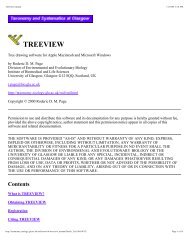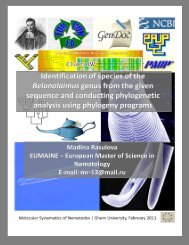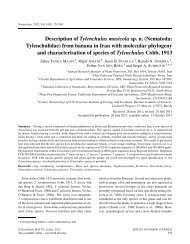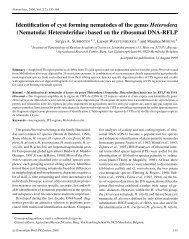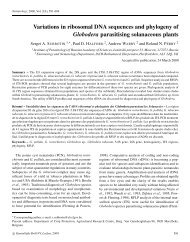Radopholus arabocoffeae sp. n. (Nematoda ... - Donimabe.org.vn
Radopholus arabocoffeae sp. n. (Nematoda ... - Donimabe.org.vn
Radopholus arabocoffeae sp. n. (Nematoda ... - Donimabe.org.vn
Create successful ePaper yourself
Turn your PDF publications into a flip-book with our unique Google optimized e-Paper software.
P.Q. Trinh et al.<br />
rior genital branch slightly longer than posterior branch.<br />
Spermatheca round, filled with thick, rod-shaped, <strong>sp</strong>erm.<br />
Oocytes in single row anteriorly or two rows near middle<br />
of ovary; genital branch sometimes reaching pharynx.<br />
Postrectal intestine sac absent. Tail long, conoid, with 40-<br />
58 annules, terminus annulated, rarely smooth, narrow,<br />
conically rounded. Phasmids distinct, located in anterior<br />
third of tail. Lateral lines fusing at two thirds of tail length.<br />
Male<br />
Slender, slightly ventrally curved after killing by gentle<br />
heat. Cephalic region set off, knob-like, with zero to<br />
three annules. Labial disc not distinct. Lateral lips terminating<br />
at junction of head and body. Stylet rudimentary<br />
with amalgamated base. Median pharyngeal bulb oval<br />
and gland lobe poorly developed. Excretory pore located<br />
at pharyngo-intestinal junction. Lateral field with four<br />
equidistant incisures at mid-body; central band of lateral<br />
field sometimes narrower than outer bands. Lateral field<br />
on tail indistinct. Phasmids located at ca one third of<br />
tail. Thick, rod-shaped, <strong>sp</strong>erm present in posterior genital<br />
tract. Postrectal intestine sac absent. Bursa usually<br />
extending to one third of tail, rarely to mid-tail. Spicule<br />
tylenchoid, with asymmetrical, oval shaped, manubrium.<br />
Gubernaculum with head more or less protruding and pronounced<br />
pair of titillae. Anterior cloacal lip with zero to<br />
three hypotygma. Tail conical, with 49 (42-61) annules,<br />
terminus rounded and annulated, rarely smooth. Hyaline<br />
part of tail narrow and short.<br />
TYPE HOST AND LOCALITY<br />
Coffee (Coffea arabica cv. Catimor) roots and soil,<br />
Krongnang District, Dak Lak province, Western Highland,<br />
Vietnam.<br />
TYPE MATERIAL<br />
One female holotype, nine female paratypes and six<br />
male paratypes deposited at the nematode collection of the<br />
Institute of Zoology, Ghent University, K.L. Ledeganckstraat<br />
35, 9000 Ghent, Belgium. Six female and two male<br />
paratypes and fixed material from cultures deposited at<br />
the nematode collection of the Nematology Department,<br />
Institute of Ecology and Biological Resources, 18 Hoang<br />
Quoc Viet, Hanoi, Vietnam.<br />
DIAGNOSIS AND RELATIONSHIPS<br />
The female of R. <strong>arabocoffeae</strong> <strong>sp</strong>. n. is characterised<br />
by a body length of 590-682 µm, the broad amphidial<br />
apertures with prominent margins, stylet length of 14.6-<br />
17.2 µm, excretory pore located at 74-90 µm from anterior<br />
end, distinct hemizonid present, lateral field completely<br />
areolated over whole body with four equidistant<br />
longitudinal incisures, four incisures at phasmid level, but<br />
lateral lines fusing at two thirds of the tail, c value of 8-9<br />
and postrectal intestinal sac absent. The male is characterised<br />
by the stylet length of 8.2-11.6 µm, dorsal pharyngeal<br />
gland orifice located 1.7-3.4 µm posterior to stylet<br />
base, rudimentary stylet with amalgamated base, excretory<br />
pore located at 72-88 µm from anterior end, <strong>sp</strong>icule<br />
18-21 µm long, gubernaculum 7.7-11.2 µm long, hyaline<br />
tail 2.6-3.4 µm long and 2.6-4.3 µm wide, and bursa never<br />
extending to the tail terminus, but usually reaching to one<br />
third of the tail length, rarely mid-tail.<br />
In having a long female tail, R. <strong>arabocoffeae</strong> <strong>sp</strong>. n.<br />
resembles R. similis, R. bridgei Siddiqi & Hahn, 1995,<br />
R. colbrani Kumar, 1980, R. kahikateae Ryss & Wouts,<br />
1997, R. musicola Stanton, Mundo, Baldwin & Kaplan,<br />
2001, and R. duriophilus Nguyen, Subbotin, Madani,<br />
Trinh & Moens, 2003.<br />
The new <strong>sp</strong>ecies differs from R. similis by the four<br />
incisures of the lateral field terminating far behind the<br />
position of the phasmid (vs three incisures terminating at<br />
or just behind phasmid), female stylet length (14.6-17.2<br />
vs 16-22 µm), and absence vs presence of a postrectal<br />
intestinal sac (Ryss & Wouts, 1997). It is further separated<br />
by the shorter male stylet (8.2-11.6 vs 13.5-16.5 µm), the<br />
shorter distance between the orifice of dorsal pharyngeal<br />
gland and the stylet base (1.7-3.4 vs 4.5-5.5 µm), bursa<br />
reaching one third of tail, rarely half vs bursa reaching<br />
tail terminus. Elbadri et al. (1999a, b) described variation<br />
within R. similis. Some of the populations examined by<br />
these authors had large, rounded amphidial apertures,<br />
but no population had amphids with broad aperture and<br />
prominent margins as in the new <strong>sp</strong>ecies.<br />
<strong>Radopholus</strong> <strong>arabocoffeae</strong> <strong>sp</strong>. n. is differentiated from<br />
R. bridgei by the lateral field having three bands equal<br />
in width vs middle one narrower than others, lateral field<br />
completely areolated over whole body vs not areolated<br />
except irregularly on neck and tail, hemizonid distinct<br />
vs indistinct, four lateral field incisures terminating far<br />
behind phasmid vs three incisures terminating at or just<br />
behind phasmid, lateral lines fusing at two thirds of the<br />
tail vs fusing at one third of the tail, longer <strong>sp</strong>icule (18-<br />
21 vs 15.5-18.0 µm), and bursa of male extending for one<br />
third of tail, rarely half vs reaching mid tail.<br />
<strong>Radopholus</strong> <strong>arabocoffeae</strong> <strong>sp</strong>.n.shareswithR. colbrani<br />
the same host but differs by the rod-like vs round <strong>sp</strong>erm,<br />
688 Nematology



